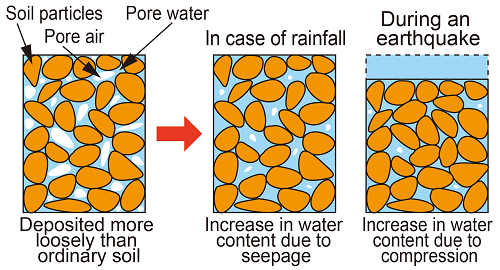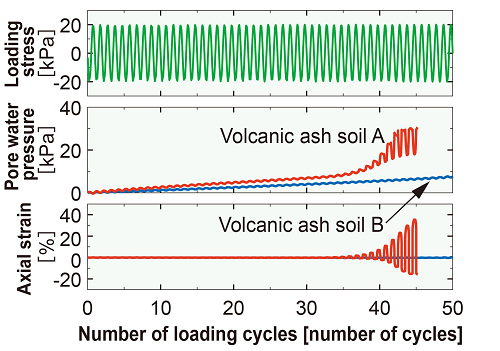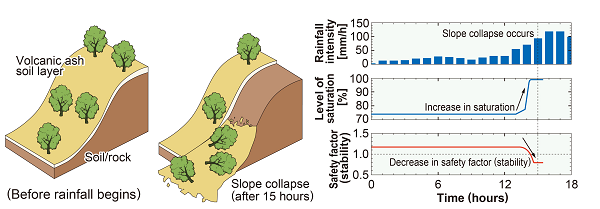29. Mechanisms underlying slope collapse due to rain or during an earthquake resulting from changes in water content of volcanic soil
Recent years have seen significant damage to tephra-covered slopes due to rain and earthquakes. Volcanic ash soil covers approximately 40% of Japan’s land surface, and is different from ordinary soil and loosely deposited. Therefore, it has a water content which varies easily in case of rainfall and during earthquakes.
Consequently, changes in deformation and strength characteristics of volcanic soil due to variations in its water content need to be clarified in order to examine the mechanisms involved in collapse of slopes constituted of this type of soil (Fig.1).
Mechanical tests were carried out on various types of unsaturated volcanic ash soil to examine changes in water content while subject to a load, in order to understand the strength and deformation characteristics of volcanic soil. Through these experiments it was found that an increase in water content reduced strength, and that even if water content was low, repeated loading increased pore water pressure and could lead to liquefaction (Fig. 2). A model was then proposed to express the variation in strength and deformation characteristics depending on changes in water content of the soil. This was then incorporated into a coupled permeation – deformation computational analysis considering the three phase conditions of soil/water/air.
Then, after carrying out a numerical analysis of an actual slope collapse it was found that an increase in water content within the volcanic ash soil layer caused slope stability to decrease, leading to deformation (Fig. 3).
By applying the mechanical tests which can take into account changes in water content together with the numerical analysis method, it was possible to clarify the mechanisms involved in volcanic ash soil slope collapse in case of rainfall and during earthquakes.
Other Contents
- 26. Head car collision testing and numerical simulation
- 27. Snow accretion simulation method for high speed trains
- 28. Ground-to-train communication system using 90 GHz band millimeter-wave
- 29. Mechanisms underlying slope collapse due to rain or during an earthquake resulting from changes in water content of volcanic soil
- 30. Factors influencing concrete deterioration due to expansion
- 26. Head car collision testing and numerical simulation
- 27. Snow accretion simulation method for high speed trains
- 28. Ground-to-train communication system using 90 GHz band millimeter-wave
- 29. Mechanisms underlying slope collapse due to rain or during an earthquake resulting from changes in water content of volcanic soil
- 30. Factors influencing concrete deterioration due to expansion



